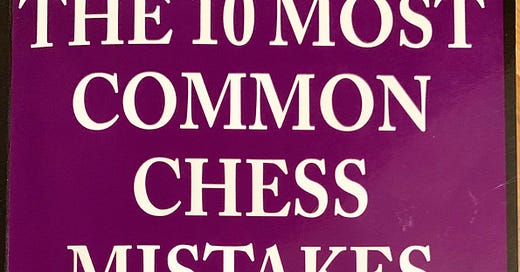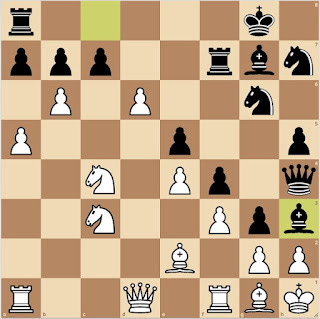Chess is a game filled with mistakes. And if none of the players make a mistake, the game is drawn. So eliminating your mistakes is essential for improvement. Thus far, I think most people will agree. But the main question is how you can work on eliminating or minimizing your mistakes in the most effective way. To this question, there are numerous opinions and theories. This post will be the first in a series of reviews on the topic of chess mistakes and improvement.
If you like these reviews, please consider supporting my work. Visit my patreon page for details.
What can you expect from this book?
Larry Evans is a name that will be familiar to many chess enthusiasts. He was a grandmaster, won the US championship multiple times, and has written several books. But although he shares his name with the famous Evans gambit, it is not named after him.
In The 10 most common chess mistakes, Evans aims to provide lessons for improving chess players by presenting a number of positions in which mistakes were made. The book is based on a rather simple principle: The reader is presented with a position and a prompt with which side has the move and two possible moves. One move is good, and the other is a mistake (the one that was made in the actual game). As a reader, you can approach this as a puzzle, or you can simply read the evaluation of each move at the bottom of the page.
Over all, the book contains 214 exercises/examples of this kind. Now, you may think I made a mistake, as the cover says there are 218 examples. There are, in fact, 218 examples/positions, but one is in the introduction and one is in the closing chapter.
The examples are categorized in ten different sections:
Bad development
Neglecting the king
Misjudging threats
Ignoring pins
Premature aggression
Miscalculation
Impulsiveness
Pawn snatching
Creating weaknesses
Inattention
These categories seem rather arbitrary, and the actual mistakes that are presented do not necessarily follow the same pattern as the other ones in the chapter. For instance, chapter 2 discusses the importance of castling, but also the importance of delaying castling when necessary. So any attempt to generalize from these examples will fall flat to the ground. You should always castle early, except when there's a reason not to.
A rather ironic way of illustrating the randomness of the categories is the introduction of chapter 10 - inattention (p. 214):
In a sense all errors can be attributed to "inattention".
This reminds me of a quote from former world champ Max Euwe: "Strategy requires thought, tactics require observation." The failure to maintain attention and observe the position correctly leads to mistakes. While this is true, it does not provide much ground for further generalization on typical mistakes. And I am sure that other authors would create different sets of categories - at least I know I would have.
The final chapter of the book, Anatomy of an error, is the best part of the entire book. It is only 8 pages long and covers just one example, but it does so in an excellent manner. The example is from a game between Ftacnik and Cvitan from 1997.
Evans begins from the position after White's 22nd move and discusses the ins and outs of the strong bishop sacrifice Bh3. He analyzes all reasonable responses to the move and concludes that White is lost. But then he asks the question how White got himself into this situation and where he went wrong. He takes the game apart in a very instructive manner and identifies a few possible alternatives for improvement.
In spite of the excellent closing chapter, I felt a bit cheated after reading the book. I was expecting some kind of insight that could provide actionable advice to help me reduce the mistakes in my own game. But what I got was nothing more than a mediocre puzzle book. The final chapter stands in strong contrast to this statement, but it is not really worth reading the entire book for that one thing.
Who should read this book?
Although the book presents itself as a guide to improvement, I think it should be seen more as a book for entertainment. If you approach it with the will to become inspired or amazed at different positions and mistakes that have been made, I am sure you will enjoy this book. But if you are looking for an effective way to eliminate your chess mistakes, I suggest you look elsewhere.
About this book
Author: Larry Evans
Title: The 10 most common chess mistakes
Type of book: Chess improvement, Tactics
Level: Beginner, Intermediate





I have this book, but haven't read it. Now I don't know if I ever will, because I was expecting to "look for an effective way to eliminate my chess mistakes." Thanks for reviewing it!